Seed Increase Trials Lead to Release of Promising New Disease-Resistant Varieties
Michael Mazourek, Cornell University

The main purpose of our project was to deliver the results of several years of organic vegetable breeding to the organic community. Previous support for vegetable breeding at Cornell fostered collaboration between university plant breeders and organic growers. This engagement led to discussions that identified needs and resources, as well as efforts in participatory breeding and evaluation of vegetables selected for performance in organic systems. The final step in making these vegetables widely available and realizing the benefits of this investment was ensuring a substantial homogeneous seed stock. With this seed stock, we could distribute samples from a single seed lot to various growers and seed companies for evaluation, while also archiving this seed lot in our storage facility for future distribution and preservation.
Many of the crops we developed are outcrossing species, which complicates seed production due to the need to isolate cultivars from one another and from other members of the same species in the area. Pollination cages were chosen as a solution recommended by USDA germplasm curator collaborators, who guided us in adopting these structures. By maintaining a hive of bees within the cage, we significantly reduced the need for manual pollination. The cages also kept out insects that could damage the plants or serve as disease vectors, some of which could be seed-borne. Although some plantings were lost to rodents that tunneled into the cages and viruses that affected populations before transplanting, we generally produced an abundant stock of healthy seed for distribution at a reasonable cost.
Originally planned as a two-year project, we unexpectedly completed our main goals within the first year. Multiple cultivars will be available in seed catalogs as organic seed. We will continue to offer seed to interested growers for trial purposes, and this year we have doubled the number of cages from four to eight. Our strategy of including multiple crops within each cage had mixed success, so we plan to optimize our approach by reducing the number of species per cage, lowering plant density, and staggering flowering periods. This year, we are producing seed from cultivars and breeding lines with disease resistances prioritized for organic production in the Northeast, and this effort will also support two other organic projects. The Toward Sustainability Foundation has funded us to evaluate and produce seed stock of cucumbers with downy mildew resistance, and we are contributing to the Northern Organic Vegetable Improvement Collaborative (NOVIC) as part of this effort.
Region
Northeast/Mid-Atlantic
Topic
Plant Breeding, Varieties, and Seeds
Category
Vegetables/Fruits, Seed Production
Date Range
2001-2010
Funding Amount
$14,953
Funding Year
2009Location
Ithaca, New York
Collaborators
Michael Glos, Freeville Organic Research Farm
Larry Robertson, USDA-ARS
Mary Kreitinger, Cornell University



